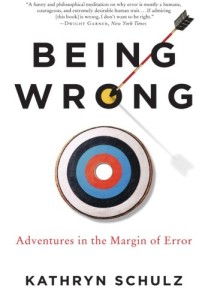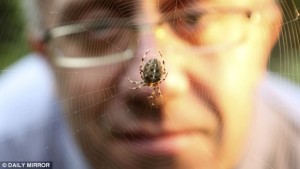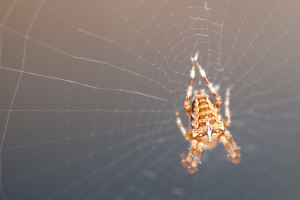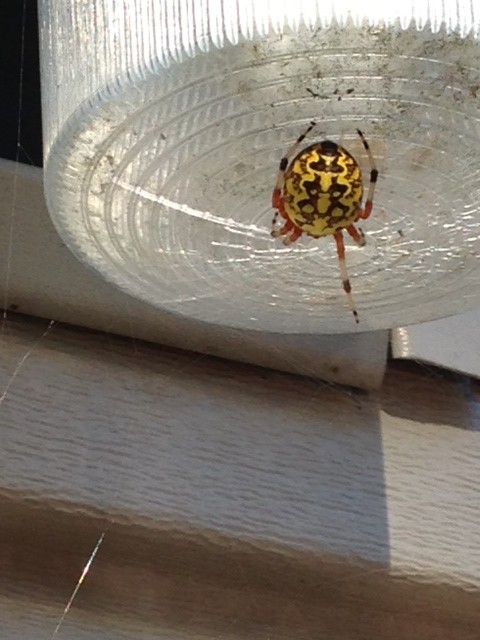Whither the widows?
First, false widows—now gay spiders. And watch out for those hobos. What is this soap opera called arachnology?
A ridiculous reality show is still playing out in the south of Britain. An insignificant spider, Steatoda nobilis, is being blamed for everything the tabloids can throw at it. I thought the story had peaked a few weeks ago, with the report that one of these Invisible Spiders (because that’s what they really are; nobody ever sees himself getting bitten) had caused a guy’s leg “to explode.” But no—the nonsense can pile up higher still.
 Now the giddiness has caused a school to close. (No worries, Brits, I’m sure all the Singaporean school children who didn’t stay home that day will eat your kids’ lunches for them, academically speaking.) There are whole platoons, brigades, of “mums” who talk about sparing their downy children from the beasties that come creeping, crawling, and snapping their way. TV hosts show helpful maps with neon arrows pointing in all directions—the spider on the march. The usual minor athlete (yes! this is another recurring theme in spider lore, the Jock with a Rash) has to sit out a crucial match because an Invisible Spider spoiled his cricket swing or his soccer moves.
Now the giddiness has caused a school to close. (No worries, Brits, I’m sure all the Singaporean school children who didn’t stay home that day will eat your kids’ lunches for them, academically speaking.) There are whole platoons, brigades, of “mums” who talk about sparing their downy children from the beasties that come creeping, crawling, and snapping their way. TV hosts show helpful maps with neon arrows pointing in all directions—the spider on the march. The usual minor athlete (yes! this is another recurring theme in spider lore, the Jock with a Rash) has to sit out a crucial match because an Invisible Spider spoiled his cricket swing or his soccer moves.
I can’t gild this lily—it stands alone. Even the calm people at the British Arachnological Society, who have been doing great work trying to drag old Blighty back toward reality, seem resigned to the fact that although they’ll get quoted here and there, they’ll make not a dent in the national arachnofoolia. It just has to play itself out.
S. nobilis has been in Britian since the 1870s. Yes, really. It looks like three other insignificant relatives, all of them prettily weaving silk doilies around Grandmum’s vegetable patch since Churchill was a lad. One day your cottage garden is a veritable Narnia of humble little animals, the next, thanks to tabloid hunger, it’s a den of deadly invaders swarming young Nigel.
So what to do? Fun as it is to see those shabby scriveners go at it, this could happen anywhere. There’s plenty of nonsense about spiders bubbling away Stateside. Not just the brown recluse fears, which a la Britain become active every time some American sprouts an ugly sore. The murky accusation against the hobo spider (Eratigena agrestis, its new name) is just as alive as ever, despite dogged research that shows, bit by unreported bit, that the hobo has almost certainly been misjudged. Its bite is probably harmless. If you can even find one. Or identify it.
How many strikes do you get again? That’s three. Hobo spider, you’re benched.
There’s an information avalanche about spiders online, so we already know that weeping skin wounds are far more likely to be staph or some other rotten microorganism or insect than a spider bite. That’s the scary part—we already know.
Now we’re getting into the realm of why people want to believe nonsense, and why facts don’t drive it out.
Here’s a great book by Kathryn Schulz. She could also have titled it “A Breath of Fresh Error.”

Kathryn Schulz doesn’t write about spiders. I think. I could be wrong. “Yes,” she says encouragingly. “That’s the idea.”
I started off resisting the author’s mission, which is to point out that everyone is wrong a whole lot but that’s not necessarily bad. Nooooooo! I want to be right all the time, or at least be able to lean back on a nice haystack of facts and studies and enjoy gazing down at the bullshit.
But.
She’s right. Beliefs guide our selection of, and adherence to, what we’re pleased to call facts. Most of the time. I think the scientific method is much more marvelous and error-correcting than she apparently does–if it’s correctly applied, self-policed, and wielded with humility. Like this hobo spider study, which disproved the venom myth from three different directions without scolding anybody who felt otherwise.
But facts fight a constant headwind of uncertainty. The culture you were born into. What your family taught you. What you feel forced to defend (“Call me an idiot because I think Invisible Spiders got my baby? Now I believe it twice as hard!”). And all the little tripwires that trigger us into seeing patterns where they aren’t, ignoring patterns we don’t want to see, trusting our lying senses, and sealing our evidence behind high walls of Just Because.
Now I’m gonna look into those gay spiders.




